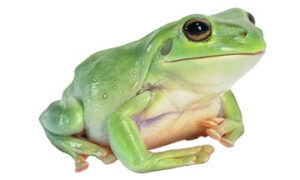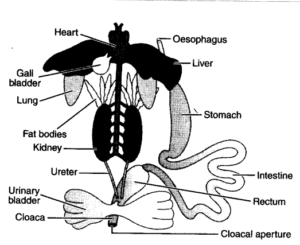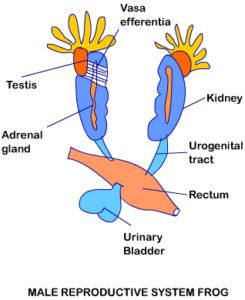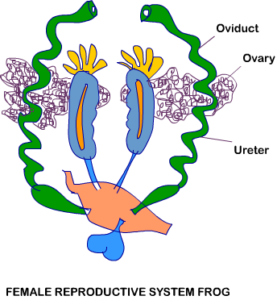Around the world most common species of frog is Rana tigrina. The frogs are cold-blooded or poikilotherms. They have the ability to camouflage. The frogs also show mimicry as a tool for protection. During summers, the frogs live in summer sleep (aestivation) and during winters, they live in winter sleep (hibernation).
Frogs are amphibians, they can live both on land and in water. Their lives begin in water when they are eggs. From the eggs, tadpoles emerge, which also live in water. When these tadpoles fully develop they begin to live on land. Let us learn more about frogs.
Frogs
- Amphibian, common Rana tigrine, Poikilotherms, shelter in a deep burrow in the extreme head (summer sleep- aestivation), cold(hibernation).
- Change color to hide them (camouflage): protective colored- mimicry.
Morphology of Frog
- Divisible to head & trunk, neck & tail absent
- Smooth & sleeper skin due to mucus, the color of dorsal side-olive green with dark irregular spots, ventral – pale yellow.
- Never drink water; absorb above mouth nostrils (+).
- Bulged eyes, covered by a nictitating membrane (protects in water)
- On either side, the tympanum receives sound signals, sexual dimorphism.
- Forelimb & hind swimming, walking, leaping, burrowing, webbed feet(swim).
- Hind limbs end in 5 digits and are larger & muscular than forelimbs that end in four digits.
- Male distinguished by sound-producing vocal sacs, copulatory pad on the first digit of the forelimb, (-) in female.
Anatomy of Frog
1 . Alimentary canal of Frog
- Short as carnivores, length of intestine less.
- Digestive system = canal + glands
- The mouth opens to the buccal cavity leads to the esophagus through the pharynx.
- The esophagus (short tube) opens into the stomach, continues as intestine, rectum & finally to the cloaca.
- The liver secretes bile stored in the gall bladder.
- The pancreas produces pancreatic juice; food is captured by the bilobed tongue.
- Digestion by the action of HCl & gastric juice in the stomach.
- Partially digested (chyme) passed to the duodenum (receive bile from gall bladder & pancreatic juice through common bile duct).
- Bile emulsifies fat & pancreatic juice digest carbohydrate & protein.
- Final digestion in intestine, by numerous fingers like fold (villi & microvilli).
- Undigested waste to rectum & pass by cloaca.
Click Here for Complete Biology Notes
2. Respiratory system of Frog
- Respire on land and water.
- In water, by skin (cutaneous), dissolved O2 by diffusion.
- On land, by buccal cavity, skin, lung(pulmonary)
- Lungs- elongated, pink coloured sac in upper part of thorax.
- During aestivation & hibernation, gaseous exchange by skin
3. Circulatory System of Frog
- Well developed, closed, the lymphatic system also.
- Involves heart, blood vessel, blood.
- Lymphatic system – Lymph, lymph channel, lymph nodes.
- Heart in the upper part of the body cavity (3- chamber), covered by the pericardium.
- Triangular Structure – Sinus venous (join right atrium), receive blood from major veins (vena cava), ventricles open into CONUS arteries on the ventral side.
- Blood from the heart is carried by arteries; veins collect from parts.
- The special venous connection between liver (hepatic portal) & intestine as well as kidney & outer parts (Renal portal).
- RBC (carry nutrient, gases, water) nucleated, hemoglobin; lymph lacks RBC & few proteins.
4. Excretory system of Frog
- Well development, (kidney + water + cloaca+ bladder)
- The kidney is a dark, red, bean-like structure in the posterior cavity, has uriniferous tubules or nephrons.
- Two Ureters emerge in male (urinogenital), open into cloaca.
- The bladder on the ventral side of the rectum opens into the cloaca.
- Carried by blood to kidney (separated & excreted), urea(ureotelic)
5. Control and coordination of Frog
- They are highly evolved, both neural and endocrine.
- Endocrine gland – pituitary, thyroid, parathyroid, thymus, pineal, pancreas, adrenals, gonads.
- Nervous system – CNS (brain + spinal cord) + PNS (cranial & spinal nerves) + ANS (sympathetic + parasympathetic)
- 10 pairs of cranial nerves, brain is enclosed in brain box (cranium) – bony.
- Brain – forebrain (olfactory lobe, cerebral hemisphere, unpaired diencephalon), midbrain (pair of optic lobes), hind brain (cerebellum & medulla).
- Medulla oblongata passes through the foramen magnum & continues into the spinal cord enclosed in the vertebral column.
6. Sensory organs of Frog
- Organ of touch (sensory papillae), taste (bud), vision (eyes), hearing (tympanum with internal ears), eyes & ears – well organized.
- Rest is cellular aggregation; the external ear is absent.
- Eyes are simple (pair of spherical structures in orbit in the skull).
7. Reproductive system of Frog
Male –
- Pair of yellowish ovoid testes adhered to the upper part of the kidney by a double fold of peritoneum- masochism. 10-12 vasa efferentia enter kidney & open to Bidder’s canal, communicate with urine-clock.
- Cloaca – small, median chamber pass fecal matter, urine & sperms.
Female
- pair of ovaries near the kidney (no functional connection with ovary), oviduct from ovaries opening to cloaca.
- Mature female 2500 to 3000 ova at a time.
- External fertilization in water, larval stage-tadpole, undergo metamorphosis to form the adult.
- Beneficial for mankind, eat an insect, protect the crop.
- Maintain ecological balance, important link of the food chain and food web.
- Muscular legs as food by man in some countries.
Related Posts
- Phylum Porifera: Classification, Characteristics, Examples
- Dissecting Microscope (Stereo Microscope) Definition, Principle, Uses, Parts
- Epithelial Tissue Vs Connective Tissue: Definition, 16+ Differences, Examples
- 29+ Differences Between Arteries and Veins
- 31+ Differences Between DNA and RNA (DNA vs RNA)
- Eukaryotic Cells: Definition, Parts, Structure, Examples
- Centrifugal Force: Definition, Principle, Formula, Examples
- Asexual Vs Sexual Reproduction: Overview, 18+ Differences, Examples
- Glandular Epithelium: Location, Structure, Functions, Examples
- 25+ Differences between Invertebrates and Vertebrates
- Lineweaver–Burk Plot
- Cilia and Flagella: Definition, Structure, Functions and Diagram
- P-value: Definition, Formula, Table and Calculation
- Nucleosome Model of Chromosome
- Northern Blot: Overview, Principle, Procedure and Results



















